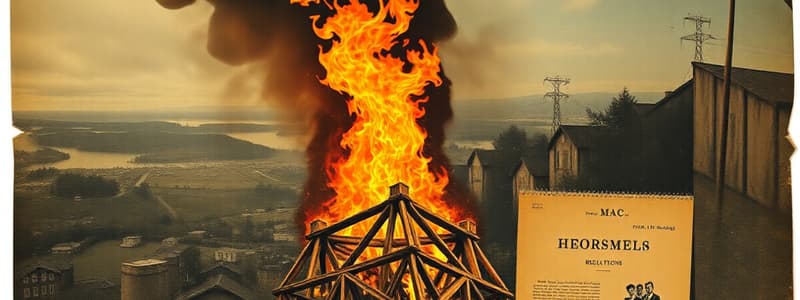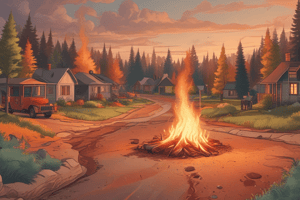Podcast
Questions and Answers
What kind of outdoor fireplace units are deemed 'approved' by the Fire Code in Toronto?
What kind of outdoor fireplace units are deemed 'approved' by the Fire Code in Toronto?
- ULC and CSA approved units, supervised and operated safely (correct)
- Solid fuel burning appliances
- Open-air burning units
- Units purchased at retail outlets throughout the city
What is the role of the Community Risk Reduction (CRR) Division in relation to Indigenous Sacred Fires?
What is the role of the Community Risk Reduction (CRR) Division in relation to Indigenous Sacred Fires?
- Approving the locations of all Indigenous Sacred Fires
- Extinguishing fires that pose a risk to public safety
- Conducting safety assessments of designated and undesignated sites (correct)
- Supervising the use of solid fuel burning appliances
Which of the following is NOT a characteristic of Indigenous Sacred Fires in Toronto?
Which of the following is NOT a characteristic of Indigenous Sacred Fires in Toronto?
- They are permitted to burn without supervision, as long as they are at a designated site. (correct)
- They can occur at undesignated sites that are notified to TFS by the Indigenous Affairs Office.
- They are not to be extinguished unless there is a public safety risk or the fire has spread from its location.
- They can occur at designated sites that are annually assessed for safety.
How are Toronto Fire Services (TFS) personnel instructed to respond to perceived Fire or safety concerns at Indigenous Sacred Fire locations?
How are Toronto Fire Services (TFS) personnel instructed to respond to perceived Fire or safety concerns at Indigenous Sacred Fire locations?
What is the purpose of entering the appropriate CAD note for Indigenous Sacred Fires?
What is the purpose of entering the appropriate CAD note for Indigenous Sacred Fires?
What is the primary difference between designated and undesignated Indigenous Sacred Fire sites?
What is the primary difference between designated and undesignated Indigenous Sacred Fire sites?
When are patio campfire units deemed 'approved' under the Toronto Fire Code?
When are patio campfire units deemed 'approved' under the Toronto Fire Code?
What type of outdoor fireplace units are explicitly deemed unacceptable according to the text?
What type of outdoor fireplace units are explicitly deemed unacceptable according to the text?
What is the primary aim of the Standard Operating Guideline regarding Indigenous Sacred Fires?
What is the primary aim of the Standard Operating Guideline regarding Indigenous Sacred Fires?
Which of the following statements accurately describes the distinction between a 'Cultural Fire' and an 'open-air burn' in the context of Indigenous Sacred Fires?
Which of the following statements accurately describes the distinction between a 'Cultural Fire' and an 'open-air burn' in the context of Indigenous Sacred Fires?
Where should written requests for open-air burning be sent?
Where should written requests for open-air burning be sent?
What is the consequence of not complying with open-air burning regulations?
What is the consequence of not complying with open-air burning regulations?
What information needs to be recorded in the Emergency Incident Reports for open-air burning incidents?
What information needs to be recorded in the Emergency Incident Reports for open-air burning incidents?
What is the purpose of the Fire Prevention Division's command offices?
What is the purpose of the Fire Prevention Division's command offices?
What is the role of the Incident Commander in an open-air burning incident?
What is the role of the Incident Commander in an open-air burning incident?
What is the difference between a campfire and a campfire effect unit?
What is the difference between a campfire and a campfire effect unit?
How can a person apply for an open-air burning permit?
How can a person apply for an open-air burning permit?
What is the file code for the Standard Operating Guideline on Open-Air Burning?
What is the file code for the Standard Operating Guideline on Open-Air Burning?
Where can you find the contact information for the Fire Prevention Division's command offices?
Where can you find the contact information for the Fire Prevention Division's command offices?
What does the acronym TFS stand for in this document?
What does the acronym TFS stand for in this document?
Who is responsible for granting approval for open-air burning in the City of Toronto?
Who is responsible for granting approval for open-air burning in the City of Toronto?
Which of the following is NOT a condition that allows for an open-air burn without approval?
Which of the following is NOT a condition that allows for an open-air burn without approval?
What document outlines the regulations for open-air burning within the City of Toronto?
What document outlines the regulations for open-air burning within the City of Toronto?
Which of the following is REQUIRED for an open-air fire to be approved?
Which of the following is REQUIRED for an open-air fire to be approved?
Which of the following BEST defines the authority level responsible for enforcing open-air burning regulations in the City of Toronto?
Which of the following BEST defines the authority level responsible for enforcing open-air burning regulations in the City of Toronto?
What is the relevant file code for this Standard Operating Guideline?
What is the relevant file code for this Standard Operating Guideline?
Which of the following scenarios would NOT require an open-air burning permit?
Which of the following scenarios would NOT require an open-air burning permit?
Which of the following is NOT a responsibility of the Incident Commander in regards to open-air burning?
Which of the following is NOT a responsibility of the Incident Commander in regards to open-air burning?
What is the purpose of this Standard Operating Guideline for Open Air Burning?
What is the purpose of this Standard Operating Guideline for Open Air Burning?
What is the date this Standard Operating Guideline superseded the previous version?
What is the date this Standard Operating Guideline superseded the previous version?
Flashcards
Open-air Burning
Open-air Burning
The act of burning materials outdoors, usually involving a large fire.
Standard Operating Guideline (SOG)
Standard Operating Guideline (SOG)
The official document that outlines policies and procedures for open-air burning in Toronto.
Toronto Fire Services (TFS)
Toronto Fire Services (TFS)
The Toronto Fire Services department is responsible for enforcing open-air burning regulations.
Ontario Fire Code
Ontario Fire Code
Signup and view all the flashcards
Incident Commander
Incident Commander
Signup and view all the flashcards
Small, Confined Fires
Small, Confined Fires
Signup and view all the flashcards
Ceremonial Fire
Ceremonial Fire
Signup and view all the flashcards
Fire Prevention Division
Fire Prevention Division
Signup and view all the flashcards
Prohibition of Open-air Burning
Prohibition of Open-air Burning
Signup and view all the flashcards
Delegation of Authority
Delegation of Authority
Signup and view all the flashcards
Open-air burning regulations
Open-air burning regulations
Signup and view all the flashcards
Reporting open-air fires
Reporting open-air fires
Signup and view all the flashcards
Information to include in reports
Information to include in reports
Signup and view all the flashcards
Requesting open-air burning permits
Requesting open-air burning permits
Signup and view all the flashcards
Open-air burning permits for cultural fires
Open-air burning permits for cultural fires
Signup and view all the flashcards
Contacting the Fire Prevention Division
Contacting the Fire Prevention Division
Signup and view all the flashcards
Permit approval process
Permit approval process
Signup and view all the flashcards
Campfire effect units
Campfire effect units
Signup and view all the flashcards
Using manufactured campfire units
Using manufactured campfire units
Signup and view all the flashcards
Powering campfire effect units
Powering campfire effect units
Signup and view all the flashcards
Outdoor Solid Fuel Burning Appliances
Outdoor Solid Fuel Burning Appliances
Signup and view all the flashcards
Patio Campfire Units in Toronto
Patio Campfire Units in Toronto
Signup and view all the flashcards
Indigenous Sacred Fires
Indigenous Sacred Fires
Signup and view all the flashcards
Designated Sites for Indigenous Sacred Fires
Designated Sites for Indigenous Sacred Fires
Signup and view all the flashcards
Undesignated Sites for Indigenous Sacred Fires
Undesignated Sites for Indigenous Sacred Fires
Signup and view all the flashcards
Fire Service Response to Sacred Fires
Fire Service Response to Sacred Fires
Signup and view all the flashcards
Designated Fire Station Notification
Designated Fire Station Notification
Signup and view all the flashcards
CAD Flagging for Undesignated Events
CAD Flagging for Undesignated Events
Signup and view all the flashcards
Extinguishing Sacred Fires
Extinguishing Sacred Fires
Signup and view all the flashcards
Categorization of Indigenous Sacred Fires
Categorization of Indigenous Sacred Fires
Signup and view all the flashcards
Study Notes
Open Air Burning Standard Operating Guideline
- Date Issued: July 29, 2022
- Rescinds: May 4, 2022
- Purpose: To provide Toronto Fire Services personnel with a guideline for incidents involving open-air burning.
- Responsibility: All personnel are responsible for awareness of open-air burning regulations within the city. Company Officers ensure these laws are enforced. Chief Officers of the Fire Prevention Division are responsible for approving open-air burning requests.
Guidelines
- Authority: The Fire Chief delegates approval authority to Chief Officers of the Fire Prevention Division.
- Ontario Fire Code: Open-air burning is not permitted within the city, enforceable under Ontario Fire Code Article 2.4.4.4.
- Exceptions: Open-air burning is allowed if it's for cooking (small, confined fire) on a grill, barbecue, or spit and is commensurate with the food being cooked, is supervised at all times, and uses appliances meeting Technical Standards and Safety Act 2000 requirements for outdoor use, assembled and installed according to manufacturer instructions.
- Enforcement: Failure to comply with open-air burning regulations is a violation of the Ontario Fire Code, and individuals can face charges.
- Incident Commander: Ensures open-air burning occurrences are reported to the Fire Prevention Division. They are also responsible for gathering and documenting information such as the owner's name, address, telephone number, etc. of the open fire incident.
Open Air Burning Approval
- Application: Requests for open-air burning permits should be made in writing or by contacting the Toronto Fire services.
- Cultural Fires: Written requests for open-air burning, including cultural fires, should be sent to the Fire Prevention Division by email or by contacting the appropriate Division command offices. Approval stamps and signatures are necessary.
- Dispatched Apparatus: Approvals are to be sent to the applicant. Incident Commanders inspect the fire location if apparatus are dispatched.
Campfire Effect Units
- Manufactured Units: Units designed to replicate campfires that use propane or natural gas are allowed, but not for food preparation and must be ULC and CSA approved.
- Solid Fuel: Solid-fuel burning appliances are not permitted.
Indigenous Sacred Fires
- Community Risk Reduction: Indigenous Sacred Fires fall under the scope of open-air/cultural fires and the Community Risk Reduction division submits and reviews requests.
- Designated Sites: Designated sites are locations identified by the Indigenous Affairs Office and assessed for safety annually. First Nations, Inuit, and Métis community members can use these sites.
- Undesignated Sites: The Indigenous Affairs Office (IAO) notifies TFS of the planned time and date of events.
- Safety Concerns: If there are safety concerns, Fire personnel should assess the situation from a distance, and intervene only if necessary. TFS will patrol fire locations to ensure safety concerns are addressed.
- Designated Locations: Stations within regions of designated sites will be advised of locations.
- Unapproved Fires: Sacred fires are not to be extinguished unless there is a public safety risk or the fire has spread beyond the designated area.
Studying That Suits You
Use AI to generate personalized quizzes and flashcards to suit your learning preferences.



